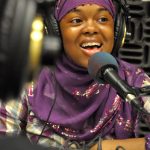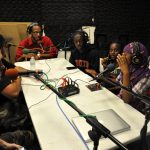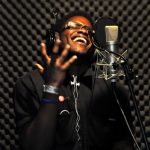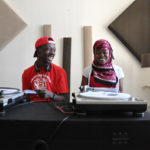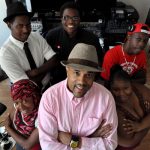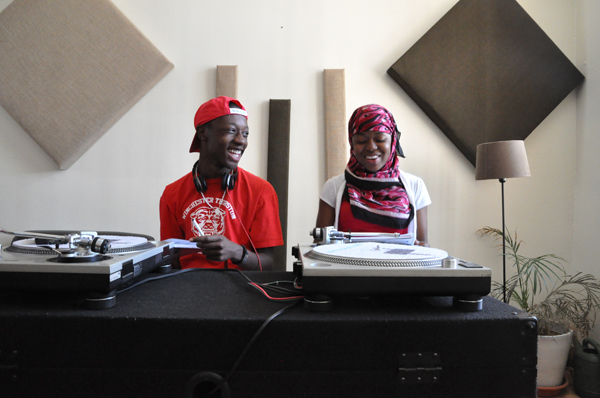
Mastering mixes with Hip-Hop on L.O.C.K.
Emmai Alaquiva says Hip-Hop on L.O.C.K., the arts education program he runs from his East Liberty recording studio, is like “‘The Apprentice’ meets ‘Making the Band.'”
Alaquiva, the former director of production at WAMO-FM, invites platoons of seven to 10 students, gathered through local school districts or community groups, to spend one day a week for eight weeks at the technological palace that is Ya Momz House, LLC.
The program’s staff — which includes emcee Chassity Cheatham, DJ Hank D and other local music personalities — teaches the kids aged 5 to 18 the basics of the music business, the history of hip-hop and the art of songwriting. As a bonus, they throw in lessons on how hip-hop artists use math and science in their art.
“Once these kids are equipped with these things, they produce, mix, master, copyright and set up for manufacturing an entire music CD,” writing every word “from conception to completion,” says Alaquiva.
Each kid typically gets to rap out a stanza or two in the “live room.” They learn to mix tracks in the sound-editing suite and watch Alaquiva in the video-editing suite turn raw footage of their experience into YouTube material. Both suites are strewn with computers and mixing boards. For inspiration, students can gaze at the awards lining the lounge area, including the gold-winged Emmy Alaquiva won regionally for the soundtrack to a WQED documentary.
In this multi-media world, the students’ lesson just start there. Hip-Hop on L.O.C.K. staffers record the students’ recording and videotaping process for short behind-the-scenes videos or more music video-style works to be posted on YouTube. They also produce “L.O.C.K. Down Radio,” a segment showcasing the work of HHOL’s young emcees, which airs on WRCT-FM, radio 88.3, Carnegie Mellon University’s station, on Tuesdays at 7 p.m. They also create “The Waffle Wopp,” an Internet show done in partnership with The Waffle Shop, the high-concept restaurant/media lab downstairs from the studio.
The end products are of astonishingly professional quality. Going back and forth from studio footage to quick interviews quotes, the YouTube videos tick-tock with the brisk rhythm of an MTV reality show. The tracks themselves are mixed using Apple’s Logic Pro, Abode Audition and other state-of-the-art software, and the rhymes are spouted into a $3,400 Neumann-U87 microphone.
“The kids use the same microphone Jay-Z would use or Kayne West would use or Beyonce would use,” says Alaquiva.
Daniel Marcus, a music teacher at Winchester Thurston School in Shadyside, has chaperoned an eighth-grade class through Hip-Hop on L.O.C.K. He says the idea of introducing kids to music through something non-traditional is not new; he taught in New York City for a few years and noted some hip-hop programs there. But he says the idea works. “If you grab them with something contemporary, they eventually move on to other stuff,” Marcus says.
And it isn’t just kids who pass through Hip-Hop on L.O.C.K. Alaquiva offers an abbreviated form of the package as a team-building exercise for businesses and nonprofit groups. Adults from these typically serious sectors end up writing and recording rap lyrics, usually relating to their group’s purpose, and even take on a hip-hop moniker.
The staff of the local branch of the drop-out prevention program, Communities in Schools, took part in the program themselves, and have also shepherded groups of kids through it. “There were a lot of moans and groans when he first talked about doing it,” says executive director Nicole Molinaro (or “Nico Beko” as she was known in the recording studio), “but people quickly got into it.”
Leadership Pittsburgh, an executive training program, and Amachi, a nonprofit serving the kids of incarcerated parents, also let out their inner Wu-Tang Clan though HHOL.
Hip-hop is as diverse as any other musical genre, yet it undeniably finds its basis in urban strife. Because of this, it is rich in both social commentary and questionable advice, depending on where you choose to look.
Alaquiva has managed to whittle hip-hop down to an exclusively positive medium for HHOL’s purposes. He says he first fell in love with hip-hop when his mother bought a cassette tape of De La Soul’s 1989 classic High and Rising. He would “bang the entire cassette tape” from beginning to end repeatedly, he remembers.
It wasn’t easy for Alaquiva growing up, he says. His mother was single and worked two jobs. (The name of his studio, Ya Momz House, is a tribute to her.) “Hip-hop was in my life regardless of good times or bad times,” he says. “Hip-hop gave me something to belong to.”
After his career gained traction (Alaquiva has been listed in Pittsburgh Magazine’s “40 Under 40” multiple times), it was natural to give back to the community, especially when he realized he had prime tools with which to do it.
“Kids understand hip-hop,” says Alaquiva. “Whether you want to admit it or not, hip-hop is the voice of youth.”
Writer: Nick Keppler
For Kidsburgh stories every week, sign up to receive Pop City via email here.
Captions: Student Zyare Martin; L.O.C.K Down Radio at WRCT; Malachi Nibbs in the sound booth; Michael Curry and Zyare Martin; (left to right, back to front) Michael Jackson, Malachi Nibbs, Michael Curry, Zyare Martin, Emmai Alaquiva, Miesha Wiley
Photographs copyright Brian Cohen
